When most retail professionals think of sales forecasting and demand forecasting, their immediate association with these terms is how they manage their supply chain.
Though this thought process is technically correct, your retail organization’s sales forecasting strategy and the technologies used to perform it should actually be going beyond the supply chain. In fact, sales forecasting is very often seen solely as a supply chain process that pricing managers, category managers, and buyers don’t have to interact with, beyond predicting demand and sales based on said demand. And truthfully, this is not the most effective way to see it for your business in terms of financial results.

If you and your retail business are also still using sales and demand forecasting only as supply chain management processes, then you are definitely missing out on other key business-driving facets they can offer insight for.
But, for starters, let’s establish the difference between sales forecasting and demand forecasting, as they are not one and the same.
Demand Forecasting vs. Sales Forecasting
Demand forecasting and sales forecasting are very similar terms — but they are not one and the same. The objective of demand forecasting is to predict the overall market demand for any given product. Sales forecasting, on the other hand, aims to predict the actual sales that a company is likely to generate based on that demand.

In essence, demand forecasting considers broad market trends and factors, while sales forecasting also takes into account internal factors like a retail organization’s specific marketing plans, stock availability, pricing approach, and so forth.
With the above in mind, why should pricing experts see demand forecasting and sales forecasting not merely as supply chain matters, but also as business drivers that they very much have an impact on?
Why Should Pricing Professionals be Deeply Involved in Demand and Sales Forecasting?
Being in control of your retail business’s prices can make or break your FY goals and all of the objectives around it. And, when it comes to demand forecasting and sales forecasting, the little steps along the way that define regular, promotional, and special pricing standards and strategies, all have a direct impact on both forecasting efforts.
Having your forecasting capabilities integrated within a broader price management solution can be eye-opening. The ability to project individual outcomes of particular pricing strategies or promotions can be a business game-changer. Imagine working directly with the impact of your pricing decisions before your teams execute these all — it’s no longer mere stock-take, and instead becomes a way to drive business across multiple strategies.

In this article, we will break down the various price management considerations that go beyond basic supply chain considerations. For each of these price management facets we will also show how this can be done within Yieldigo software. The aim is to show how pricing experts can use price management software to positively and directly impact both demand forecasting and sales forecasting.
Finally, we will explain how demand forecasting and sales forecasting are neither straightforward nor linear processes. We will analyze how everything from stockouts to seasonality trends can be predicted, but only based on mathematical probabilities, and not crystal ball absolutism.
Let’s start with how pricing pros can help build accurate and financially sturdy cross-organizational demand and sales forecast visibility by performing well-executed daily pricing activities in price management software. This will allow us to see why and how pricing experts are an essential part of demand forecasting and sales forecasting, beyond mere supply chain purposes.
Going Beyond the Supply Chain with Price Management Software
Modern and complex price management software like Yieldigo can be broken down into three core pricing facets: Regular Pricing, Promotional Pricing, and Markdown Pricing.
Within the software and daily use, this can be seen in:
- Utilizing what-if simulations in the Regular pricing strategy setup.
- Setting effective Promotions with upfront knowledge of their impact.
- Managing Markdown discounts (the Markdown Optimization feature from Yieldigo will be available soon, with an accompanying article to help you make the most of this pricing technique) to clear inventory with minimal margin loss.
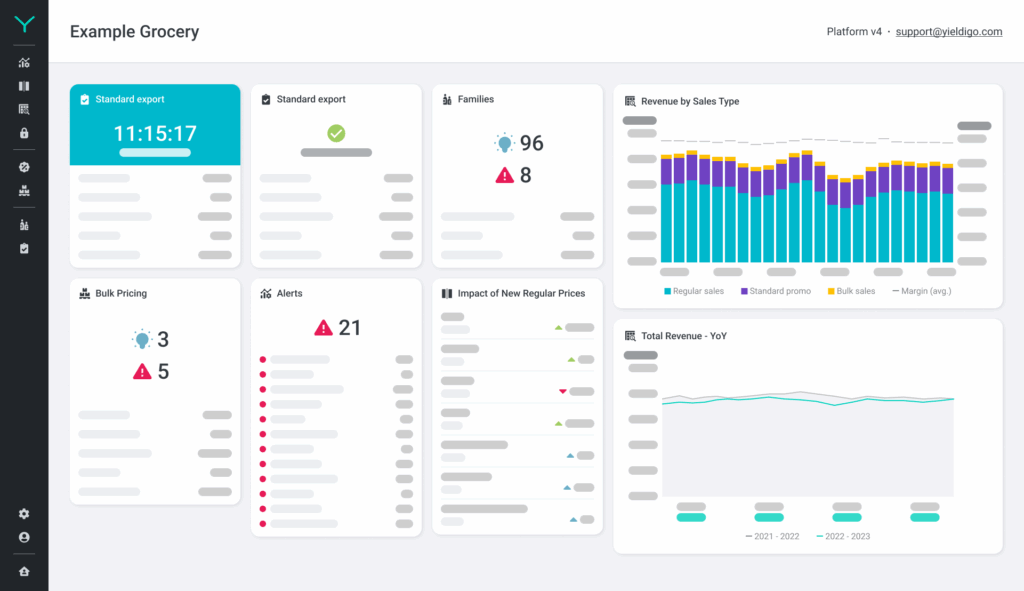
If you would like to learn more about the inner workings of what-if simulations and promotion planning, you can click on the above links or feel free to read some of our other articles on similar topics. In this article, we are exploring how these three pricing facets are a critical contribution to gaining real-world insights that can help establish forecasting, within any given retail organization.
Let’s now evaluate how each of these pricing facets play a key role in establishing forecasting.
What-If Simulations in Regular Pricing and Impact on Forecasting
What-if scenarios are an advanced ML/AI pricing technology that allows end-users to test pricing strategies before they are launched. They are a critical part of Yieldigo’s various regular pricing modules. The ability to test pricing strategies and foresee potential results of any given strategy can be a pinnacle part of establishing both demand forecasting and sales forecasting projections.
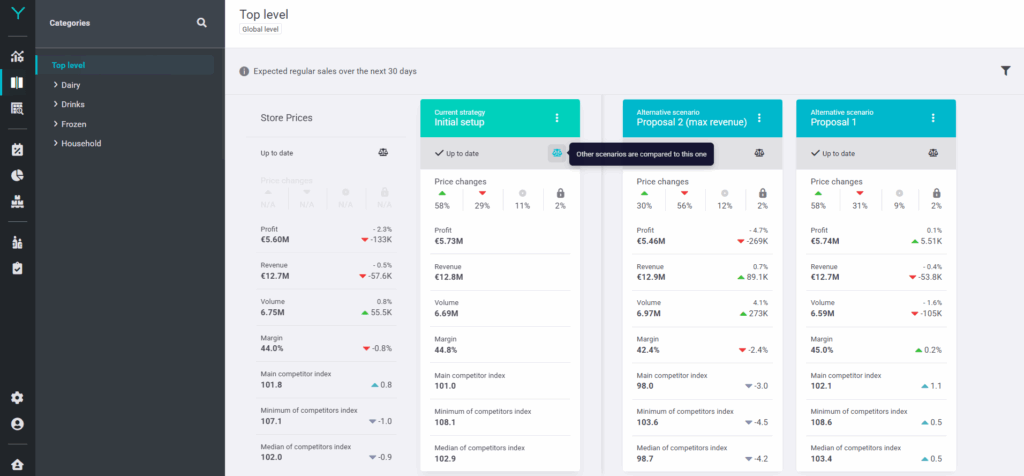
It’s easy then to arrive at the conclusion that if pricing managers are tracking their pricing strategies correctly, both the demand of items needed and the sales figures expected to be yielded from these efforts are being taken into account. These then can be input into demand forecasting and sales forecasting predictions.
Promotional Pricing and Impact on Forecasting
Yieldigo’s Promo Planner and Promo Dashboard are two core promotion management modules that help analyze and oversee the impact of your promotions. Very similar to the technology used in what-if within the regular pricing facet of the software, the promo planner offers the Promotion Simulator feature. The Promotion Simulator is an ML/AI feature that offers price elasticity per SKU or bundle, based on your data inputs.
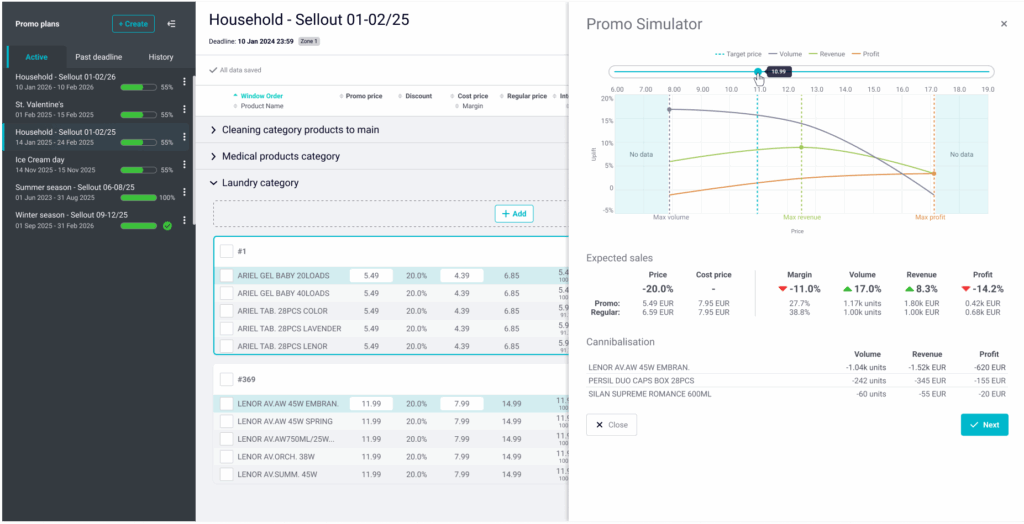
As such, being able to predict the overall impact of promotions using ML/AI software features in itself is a great contributor to both decision making and forecast planning. Within the figures offered by the Promo Planner there is clear visibility and control over promotions that allows upper management to see how much their retail organization can expect to earn from promotions. This then paves a clearer path towards a more accurate demand and sales forecast thanks to these promotional planning insights.
Markdown Optimization and Impact on Forecasting
Having to throw away produce due to the passing of expiry dates on products is wasteful for our planet as much as it is for a retail organization’s margins. Markdown Optimization is a great way to automate the repricing of goods that are going past their prime, in order to minimize losses on the product, but also to help prevent food waste. Best of all, this can help margin retention significantly.
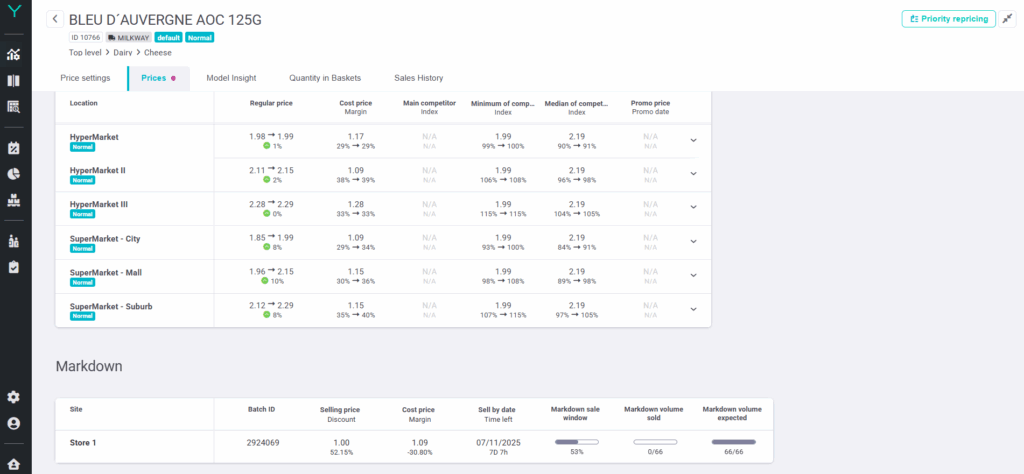
Using ML/AI to track product expiration dates and ensuring that the product is sold off the shelf and not chucked into the dumpster is a very smart margin-retention method. In order to achieve this, it’s critical to work with a reliable forecasting engine that can predict the sales of the products under different markdown scenarios. Accurate forecasts are the key to effective Markdown Optimization.
Demand Forecasting and Sales Forecasting in Yieldigo: Managing Complexity with Precision
Demand forecasting and sales forecasting in Yieldigo retail price management software is designed to bring clarity and actionable insights to some of retail’s most unpredictable dimensions: demand and projected sales. Our ML/AI software uses advanced algorithms that process a wide range of factors to deliver reliable predictions and figures that empower retailers to make smart, data-driven decisions.
How Does It Work?
Accurate demand forecasting can be a challenging task in situations when dealing with sparse sales, newly listed inventory, frequent stockouts in the past, and similar scenarios. In fact, it’s almost never a simple and straightforward process. Let’s go through the typical hurdles this applies to and break down the logic behind each so that it is clear why sales forecasting is often not a linear process with evident outcomes.

Sparse Sales Data Products
One of the most frequent challenges our clients face is dealing with sparse sales data — products that are sold infrequently, with little to no pattern or seasonality to learn from. For sparse sales data products, prediction errors are naturally higher, as there’s less behavioral data to anchor the model. However, the system is built to recognize these limitations and adjust expectations accordingly. To estimate some of the factors such as seasonality or price elasticity, category-level patterns and similar product behavior is used to bridge the gap.
Stock Outs
A common concern is whether stock-outs distort the forecasting results. In Yieldigo, stock-outs are automatically detected and corrected for, so that periods where products were unavailable do not mislead demand projections. This ensures the forecast represents actual customer interest, not inventory shortfalls.
Promotional Uplifts
Promotional uplifts are another highly complex prediction. When an item is being promoted for the first time, there’s no past promotion data to rely on. In such cases, the software draws from the behavior of similar products within the same category to estimate likely outcomes. This peer-based approach allows for reasonably accurate estimations even in new promotional scenarios.
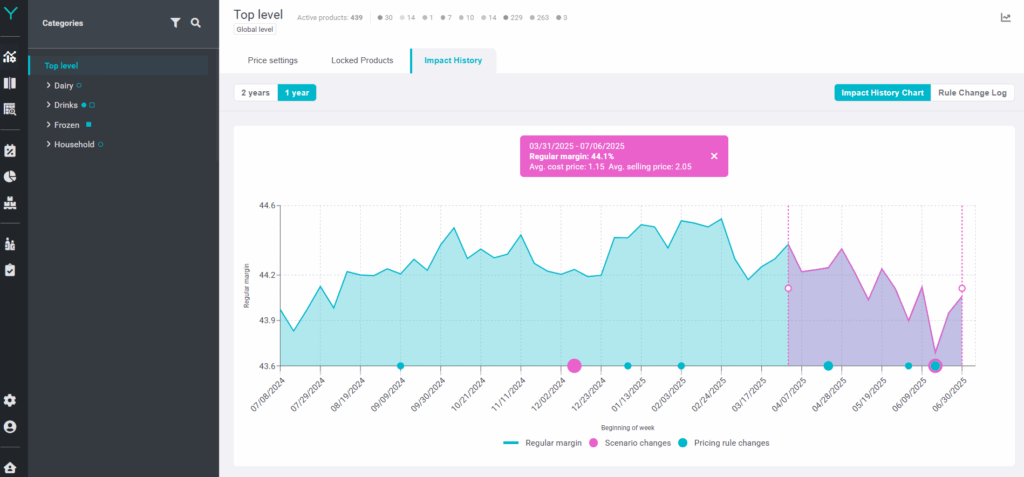
Historical Data
Retailers often ask how much historical data is necessary for effective forecasting. While Yieldigo can work with as little as two months of data, the ideal window is two or three years. This duration provides the necessary perspective to uncover deeper patterns, such as yearly seasonality and trends, promotional effects, or holiday-driven fluctuations.
Newly Listed Items (No Sales History)
Newly listed items with no sales history present a unique case. Because they tend to be unstable in their early performance, Yieldigo does not assign separate forecasting models to them initially. Instead, they are evaluated within the broader context of their product category or family. If a new item belongs to an existing family, it can inherit behavioral patterns from its relatives—accelerating its forecast maturity.
Internal and External Factors
The forecasting engine also considers a rich variety of external and internal factors. These include weather conditions, calendar holidays, promotional mechanics, price elasticity, and client-defined constraints like pricing rules or competitor benchmarks. When factors like weather or in-store product placement have a statistically significant influence, they are integrated into the model—provided the product-level data is correctly flagged. This highlights the critical importance of clean, well-labeled data to achieve best possible forecasts.
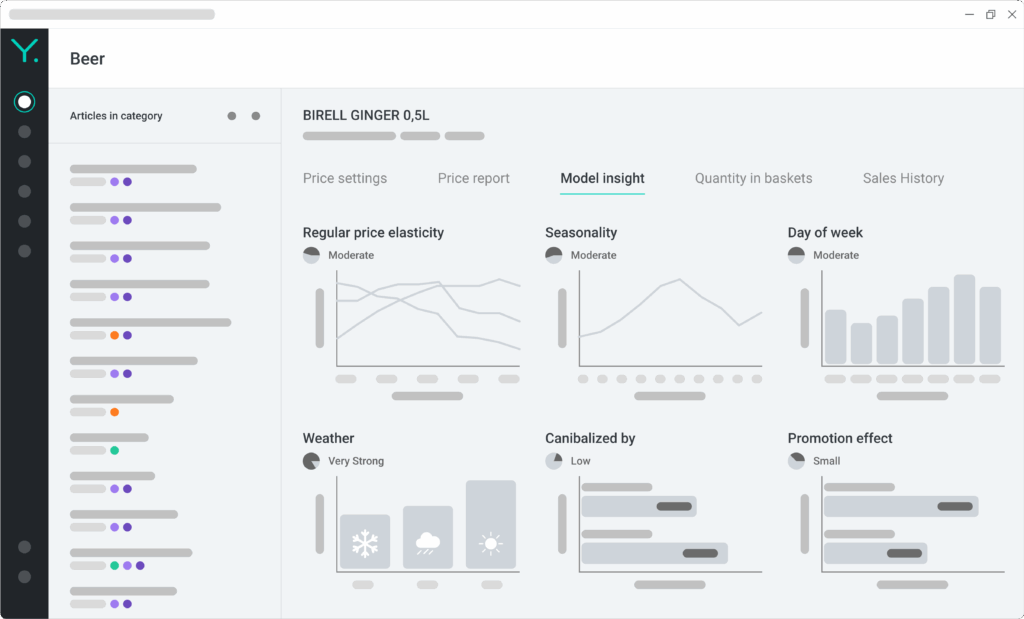
Seasonality
Seasonality and public holidays are detected automatically, but this depends heavily on the availability of robust historical sales data—at least at the category level. When direct product data is insufficient, category-level patterns serve as a surrogate to bridge the gap. Similarly, for long-range forecasts, such as those stretching 60 days into the future, internal models are used to project weather effects, assuming a proven category-level sensitivity to those conditions.
Forecast Accuracy: What to Expect
Yieldigo’s forecasting models aim to strike a balance between mathematical rigor and real-world applicability. However, it’s important to recognize that accuracy can vary greatly depending on several key factors.
First and foremost, stability in historical sales is essential. Some products, such as short-lived in-out items, highly seasonal SKUs, or produce with inconsistent SKU labeling (common in fruits and vegetables), naturally carry more volatility and therefore higher forecast error. These cases are not failures of the model, but rather reflections of the complexity and inconsistency in the data they rely on.

Another important consideration is the level at which forecast accuracy is measured. While forecasts might be highly reliable at an aggregated level—say, total sales across a region or chain—they can show significant volatility when broken down to individual store and daily granularity. This is a common statistical reality in forecasting, and one that clients should plan for when interpreting results.
Finally, data quality plays a foundational role in forecast performance. Even the most sophisticated models will struggle with poor or incomplete data. Yieldigo prioritizes close collaboration with clients to improve data hygiene, offering feedback loops and iterative tuning to ensure the input is as clean and structured as possible. After all, no model can perform magic on chaotic inputs—but with clear, consistent data, the results can be remarkably powerful.
Conclusion: Fortify Your Sales Forecasting and Demand Forecasting with Price Management Software
Seen often as a mere supply chain process that pricing managers, category managers, and buyers rarely get involved in, the results yielded from demand forecasting and sales forecasting discussions are deeply rooted in your retail organization’s daily pricing mechanism. As such, it is evident from what we saw in this article that using ML/AI price management software can enable you to make data driven decisions considering their forecasted impacts. In the end, your retail brand’s daily pricing routines and the data used and rendered in order to propel these processes are a wealth of information for the bottom line.
If you’d like to learn more about how Yieldigo can help your team establish more accurate demand forecasting and sales forecasting, you can talk to our pricing expert.


